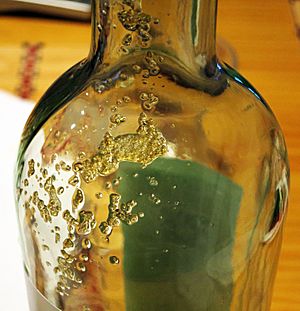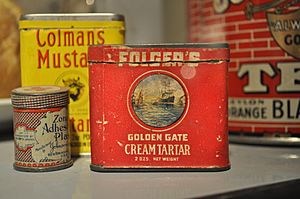Potassium bitartrate facts for kids
Quick facts for kids Potassium bitartrate |
|
|---|---|
 |
|
| Other names | potassium hydrogen tartrate cream of tartar potassium acid tartrate monopotassium tartrate potassium;(2R,3R)-2,3,4-trihydroxy-4-oxobutanoate |
| Identifiers | |
| CAS number | |
| PubChem | |
| SMILES | [C@@H]([C@H](C(=O)[O-])O)(C(=O)O)O.[K+] |
|
InChI
InChI=1/C4H6O6.K/c5-1(3(7)8)2(6)4(9)10;/h1-2,5-6H,(H,7,8)(H,9,10);/q;+1/p-1/t1-,2-;/m1./s1
|
|
| Properties | |
| Molecular formula | |
| Molar mass | 0 g mol-1 |
| Appearance | white crystalline powder |
| Density | 1.05 g/cm3 (solid) |
| 0.57 g/100mL (20 °C) 6.1 g/100mL (100 °C) |
|
| Solubility | soluble in acid, alkali insoluble in acetic acid, alcohol |
| Refractive index (nD) | 1.511 |
| Except where noted otherwise, data are given for materials in their standard state (at 25 °C, 100 kPa) | |
Potassium bitartrate is a chemical compound that you might know better as cream of tartar. It's a common ingredient in many kitchens! This substance is a natural byproduct of winemaking, meaning it forms during the process of making wine.
Its chemical formula is KC4H5O6. Cream of tartar is made from a special kind of salt of tartaric acid, which is a type of carboxylic acid. This powdery acid can be used in baking. It can also be used as a cleaning solution when mixed with acidic liquids like lemon juice or white vinegar.
Contents
Where Does Cream of Tartar Come From?
Potassium bitartrate often forms as crystals inside wine barrels. This happens during the fermentation process, which is when grape juice turns into wine. You might also see these crystals in bottles of wine, especially if they've been stored in a cool place (below 10°C). These crystals are sometimes called "wine diamonds." They usually stick to the bottom of the cork and don't dissolve back into the wine.
These crystals can also form in fresh grape juice if it's chilled or left to sit for a while. If you're making homemade grape jam or jelly, you can chill the grape juice overnight. This helps the potassium bitartrate crystals form. Then, you can remove them by filtering the juice through a cheesecloth. Sometimes, the crystals just stick to the side of the container, so you don't even need to filter.
The rough form of these crystals is called beeswing. This crude form is collected and then cleaned. The result is a white, odorless, acidic powder that people use for cooking and other household tasks.
Uses of Cream of Tartar
Cream of tartar has many different uses, especially in the kitchen and around the house.
In the Kitchen
In cooking, potassium bitartrate, or cream of tartar, is used for several things:
- Stabilizing Egg Whites: It helps egg whites hold their shape better when whipped. It also makes them able to handle more heat and increases their volume.
- Stabilizing Whipped Cream: It helps whipped cream stay firm and fluffy, keeping its texture and volume.
- Anti-Caking and Thickening: It can stop powders from clumping together. It also helps make foods thicker.
- Preventing Sugar Crystallization: When added to sugar syrups, it helps prevent the sugar from turning into crystals. It does this by breaking down some of the sucrose into glucose and fructose.
- Reducing Vegetable Discoloration: It can help keep boiled vegetables from changing color too much.
Cream of tartar is also a key part of other mixtures:
- Baking Powder: It's an important acidic ingredient in Baking powder. It works with baking soda to create bubbles, which makes baked goods rise.
- Sodium-Free Salt Substitutes: It's sometimes mixed with potassium chloride to create salt substitutes that have less sodium.
Another similar ingredient, sodium acid pyrophosphate, is also used in baking powder. People sometimes confuse it with cream of tartar because they do a similar job.
Around the House
Potassium bitartrate can be very useful for cleaning:
- Cleaning Metals: You can mix cream of tartar with an acidic liquid like lemon juice or white vinegar to make a paste. This paste is great for cleaning metals such as brass, aluminum, or copper.
- Removing Stains: You can also mix it with water to clean light stains from porcelain.
- Removing Rust: When mixed into a paste with hydrogen peroxide, cream of tartar can help remove rust from hand tools like files. You apply the paste, let it sit for a few hours, then wash it off.
Cream of tartar was also used in traditional dyeing processes. It helped adjust how well certain salts, called mordants, dissolved. This was important for making dyes work correctly.
It can also be used to slow down how quickly plaster of Paris sets. This is helpful in construction and art when working with plaster.
For Cosmetics
When dyeing hair with henna, potassium bitartrate can be mixed in. It acts as a mild acid that helps activate the henna, making the dye work better.
In Chemistry Labs
Potassium bitartrate is used as a standard for pH buffers by the National Institute of Standards and Technology. When you mix an excess of this salt in water, it creates a solution with a specific pH level (3.557 at 25°C). This makes it useful for calibrating pH meters in science labs.
See also
 In Spanish: Bitartrato de potasio para niños
In Spanish: Bitartrato de potasio para niños



